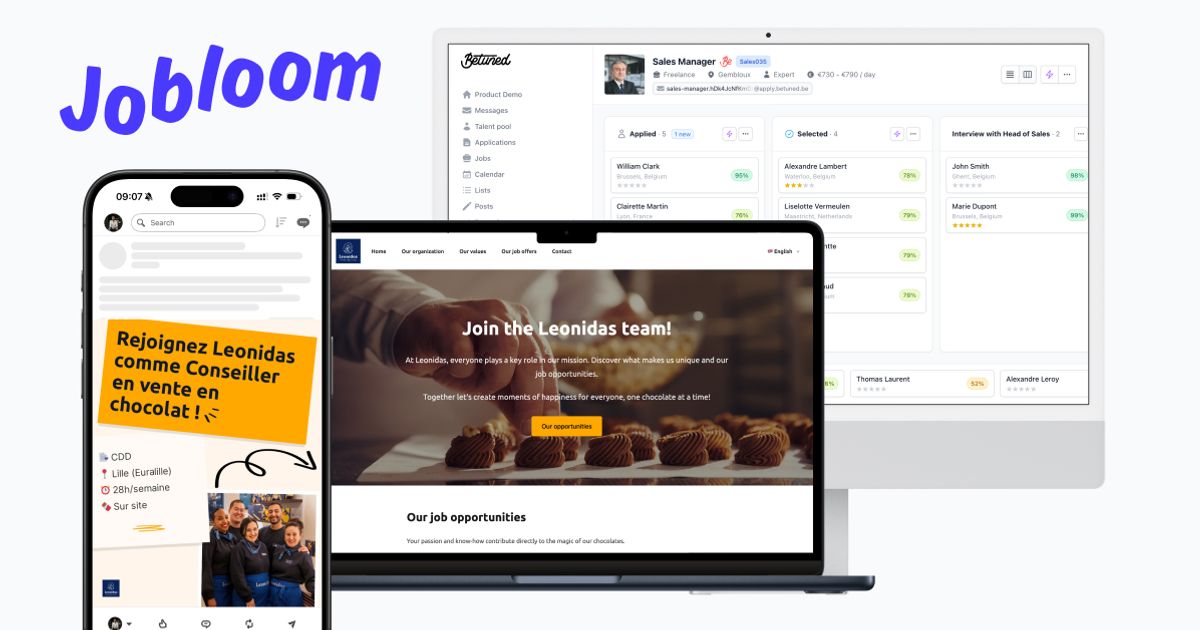Automation is no longer enough. From predictive AI to skill platforms, discover 5 tech trends that put humans at the heart of HR strategy.
For many HR leaders, technology has long been synonymous with automation: payroll management, leave tracking, resume sorting. These optimizations, while necessary, are just the tip of the iceberg. The real revolution, the one that is unfolding today, is strategic in nature.
Artificial intelligence, data analysis, and smart platforms are no longer just about performing tasks. They enhance our decision-making abilities, allow us to understand human dynamics with unprecedented depth, and transform the HR function from an administrative cost center into a driver of performance and growth for the company.
This article does not merely list innovations. It provides you with a roadmap to understand how these trends will impact your core missions: attracting the best, developing their potential, and building resilient organizations.
1. From the Resume to Data: Recruitment Enhanced by AI
Yesterday, recruitment was based on the analysis of a resume and the recruiter's intuition. Tomorrow, it will be a predictive science based on a multitude of data points. Technology does not replace human judgment; it enhances it by providing a holistic and objective view of the candidates.
How does it work?
Modern AI algorithms go well beyond simple keyword filtering. They can:
- Analyzing cross-functional skills: By cross-referencing information from a LinkedIn profile, an online portfolio, and responses to situational exercises, AI can identify soft skills such as problem-solving or leadership abilities.
- Assessing Cultural Fit: Through semantic analysis of written or video responses, tools can evaluate a candidate's alignment with the company's values and operating mode, thereby reducing casting errors.
- Predicting performance: By modeling the paths of the most successful employees, these systems can identify external profiles that exhibit the same markers of potential success.
The goal: Reduce unconscious biases, speed up the selection process and, above all, drastically increase the success rate of hiring by focusing on actual potential rather than a linear career path.
2. Predictive Analysis: Anticipating Disengagement to Better Retain
The cost of an employee's departure is colossal, both financially and organizationally. Instead of reacting to a resignation, the most advanced HR technology now allows for proactive action. Predictive analysis is your best ally in transforming retention into a proactive strategy.
Identify weak signals
By analyzing anonymized and aggregated diverse data, HR platforms can detect patterns that are precursors to disengagement:
- Decrease in participation in internal communications.
- Fewer collaborations on cross-functional projects.
- Changes in the patterns of connection or use of the company's tools.
Concrete example: A system could alert an HR manager that a high-potential employee, whose performance is stable, has stopped participating in optional training programs and is interacting less on team channels. This is a subtle signal that invites starting a conversation well before the situation becomes critical. The company can then offer a new project, targeted training, or an adjustment of their tasks.
3. The Hyper-Personalization of Continuing Education through AI
The era of the "training catalog for everyone" is over. In an environment where skills quickly become obsolete, learning agility is key. AI transforms training into a continuous, personalized experience that is integrated into the daily life of the employee.
Custom development paths
AI-powered Learning Experience Platforms (LXP) do more than just suggest content. They create dynamic career paths.
- Skills gap analysis: The tool compares an employee's current skills (derived from their evaluations, projects) with those required for their next role or for the company's future strategic needs.
- Contextual recommendations: The platform then offers micro-learning sessions, articles, podcasts, or connections with internal mentors, at the exact moment the need arises.
Some companies take the concept further with virtual coaches who help employees set their career goals and offer them tailored resources in real-time, enhancing their autonomy and engagement.
4. The End of Intuition: Driving HR Strategy with Data and ROI
For years, HR departments have struggled to prove their tangible impact on business outcomes. Data visualization and HR data analysis (People Analytics) are radically changing the game. The HR function can finally speak the language of the executive committee: that of return on investment (ROI).
From data to strategic decision
Technology enables the connection of HR initiatives to key performance indicators (KPIs):
- Measuring recruitment effectiveness: Which sourcing channel brings in candidates who stay the longest and perform the best?
- Assessing the impact of well-being: Is there a correlation between team engagement scores and their business performance?
- Optimizing budgets: Which training program generates the highest increase in productivity?
Thanks to clear and dynamic dashboards, HR managers can justify their investments, adjust their strategies in real time, and demonstrate their essential role in achieving overall objectives.
5. Towards Agile Organizations: Tech at the Service of Collective Performance
The latest disruption, and perhaps the most profound, does not concern the individual but the collective. Technology now provides tools to analyze and optimize the very structure of the organization, promoting agility and innovation.
Mapping social capital
Tools like Organizational Network Analysis (ONA - Organizational Network Analysis) enable the visualization of actual communication and collaboration flows, beyond the formal organizational chart. HR managers can thus:
- Identify informal influencers who are essential for driving change.
- Identify teams working in silos and create bridges to foster innovation.
- Form project teams not on the basis of titles, but on the basis of proven collaborative dynamics.
By using these insights, an HR director can surgically restructure teams to unlock performance, based on tangible data rather than solely on intuition.
From Vision to Action: Make Your HR Strategy a Reality with Jobloom
Understanding these trends is the first step. Implementing them to gain a competitive edge is another. HR digital transformation is not a matter of tools, but of integrated strategy. This is precisely where Jobloom comes in.
We are not just a software provider. We are your strategic partner to make these innovations a tangible reality within your organization.
- Enhanced Recruitment (Points 1 & 4): Our smart ATS and our custom career sites do more than just handle applications. They collect valuable data to help you make informed decisions, measure the ROI of your campaigns, and build a holistic view of your talent.
- An Employer Brand that Attracts and Retains (Point 2): Through our impactful job videos and our Employer Branding consulting, we help you reveal your unique DNA. A strong and authentic culture is the best defense against disengagement.
- A Content Strategy for the Digital Age (Points 3 & 5): We produce expert content that positions your company as a thought leader, naturally attracting talents who share your vision and wish to grow with you.
Ready to transform your HR function into a true growth engine?
Let's plan a strategic exchange to align your vision with the best technologies in the market.
The latest

Recruter sans outils digitaux, c’est un peu comme pêcher sans filet : on finit par passer à côté des meilleurs profils.
Aujourd’hui, les candidats veulent postuler aussi facilement qu’ils commandent sur Amazon — et si ce n’est pas le cas, ils passent à l’offre suivante.Voici les 10 erreurs les plus fréquentes que font encore (trop) de PME… et comment les éviter.1. Un site carrière figéUne simple liste d’offres ou des PDF à télécharger → taux de conversion quasi nul (0 à 2 %).2. Pas de mobile firstAlors que plus de 90 % des candidatures se font sur smartphone.3. Des formulaires à rallongeLettres de motivation obligatoires, 20 champs à remplir, étapes multiples… les candidats fuient.4. Aucune marque employeurPas de contenu qui donne envie de rejoindre votre boîte plutôt qu’une autre.5. Des process éclatésCandidatures par mail, suivi dans Excel, CV dans Dropbox → perte de temps et d’efficacité.6. Pas de base de données centraliséeOn oublie les bons candidats, on recontacte les mêmes profils, on perd la mémoire collective.7. Pas de visibilité multicanalLes offres ne sont publiées que sur LinkedIn ou Indeed → portée limitée.8. Zéro automatisationLes recruteurs passent des heures à trier ou envoyer des refus manuellement.9. Manque de feedback candidatAucune réponse claire ou rapide → image employeur abîmée.10. Recrutement perçu comme administratifAlors qu’avec les bons outils, on peut redonner du temps à l’humain, à l’échange, à la rencontre.La bonne nouvelle ? Tout ça se corrige facilement.Avec Jobloom, les PME peuvent digitaliser leur recrutement sans perdre leur authenticité — et sans se ruiner.Vous avez envie de voir comment ça marche ?

Christelle Lempereur, DRH de Léonidas.
" Nous avons reçu 55 candidatures sur un profil atypique et ça, c’est parce que cette offre publiée par ce site (jobloom) génère beaucoup d’attractivité et beaucoup de visibilité. "

Christophe Degauquier, Managing director DAP
" En termes d’efficacité et d’outils digitaux, nous avons été très positivement surpris, et pour un prix tout à fait raisonnable. Cela a créé une petite révolution chez nous en matière de recrutement."

Kévin Coppens, Co-fondateur de Semactic.
"Jobloom nous a permis de nous structurer et d’adopter une approche RH cohérente, pertinente et bien définie, autant pour nous que pour les candidats."
You might also like

I see evolution on one side, potential on the other. And I savor it!
On the left, Charlotte Courtat. She started as a junior recruiter at Betuned. Today, she is Product & Account Manager at Jobloom. Three years of learning, testing, and growing in power. And frankly, what a rise. Bravo, Charlotte! On the right, Romane Willemart. She started this week as a junior in digital communication. She's discovering everything, asking lots of questions, observing… and we already feel that she won't stay in the shadows for long. Welcome, Romane! This kind of photo is more than just a team snapshot. It's a reminder that talent reveals itself with time, trust, and a little space to dare. And me? I'm here, watching it all with a mix of pride, admiration… and a lot of enthusiasm for what's next!Let's Bloom!

Mastering Boolean Search: Your Lever to Find the Best Candidates
Switch to proactive sourcing. Our practical guide teaches you how to master Boolean search (AND, OR, "") to uncover hidden talents before your competitors do.Boolean search. This technical term may seem complex or even intimidating at first glance. Many HR professionals hesitate to delve into it.Yet, behind this name lies a candidate sourcing method of formidable efficiency, and much more accessible than it seems. A few minutes of reading will suffice to reveal its fundamental principles and to transform your approach to recruitment.This advanced search technique may seem daunting, but it is an extremely effective solution for identifying qualified profiles on essential platforms like Google or LinkedIn. In a job market where talent is scarce, Boolean search is an often underutilized strategic asset that can give you a head start.Boolean Search: Definition and Fundamental PrincipleBoolean search is a precise search methodology that relies on logical operators (such as AND, OR, NOT) to refine and target the results of a query.→ Its scope is broad: it is just as relevant for finding profiles on Google as it is on professional networks (with LinkedIn being the foremost) or job boards. In summary, whenever there is a search bar, there is a strong likelihood that you can use it to optimize your searches.For instance, to find an experienced front-end developer in Lyon, your Boolean search could be phrased as follows: (front-end developer OR front-end engineer) AND Lyon AND (React OR Angular) AND experience > 5 yearsEssentially, Boolean search gives you the power to construct a structured query to filter out the noise and only surface profiles that very precisely match your criteria.Why Boolean Search is a Strategic Asset in Recruitment?The main advantage of Boolean search in recruitment lies in its ability to streamline and speed up the sourcing process. By using logical operators, recruiters can refine their searches to target only candidates who perfectly match their requirements.👍 Considered an insider's sourcing technique, Boolean search allows for a dramatic time-saving. It automatically filters out irrelevant results, enabling you to focus exclusively on the most promising profiles.Moreover, this method provides unmatched agility and adaptability. Recruiters can adjust and modulate their queries in real time to meet the changing needs of the business or market fluctuations. It is an essential tool for identifying top talent quickly and efficiently.🦾 It is also a skill that few recruiters master perfectly, which gives an undeniable competitive advantage to those who use it.The Essential Boolean Operators to MasterBefore you start hunting for talent on the web, mastering key operators is essential. Here are the most important ones and their practical application:Operator "AND": This operator is used to narrow down a search by requiring the presence of all the specified terms. It is ideal for combining mandatory criteria.Example: For a Digital Project Manager proficient in English and agile tools in Paris: "Digital Project Manager" AND English AND Agile AND Paris.Operator "OR": The "OR" operator is used to broaden a search by including alternatives. The result will display profiles containing either of the terms.Example: For a Data Analyst or a Data Scientist in Lille: ("Data Analyst" OR "Data Scientist") AND Lille.Operator "NOT" (or the "-") sign: This operator is used to exclude specific terms from your results.Example: To find profiles of experienced salespeople, but without juniors or apprentices: B2B Sales AND experienced NOT junior NOT apprentice.Operator "SITE:": Useful for focusing your search on a single website. It must be in lowercase, followed by a colon and the site's URL, without any spaces.Example: To search for "Marketing Directors" exclusively on LinkedIn: site:linkedin.com/in "Marketing Director".Operator "EXT:": This operator allows you to search for specific file types (PDF, DOCX, etc.), very useful for finding resumes online.Example: To find resumes for "Management Controller" in PDF format: CV "Management Controller" ext:pdf.Refine your searches using punctuationBeyond operators, punctuation is your ally for even more surgical queries.Guillemets (" ") : Utilisez-les pour rechercher une expression exacte. La recherche ne remontera que les résultats où les mots apparaissent dans cet ordre précis.Example: "Human Resources Manager" will target this exact position, and not profiles containing "manager" and "human" separately.Parentheses ( ) : They are crucial for grouping terms and controlling the order in which operators are applied, especially when combining AND and OR.Example: For an experienced salesperson in Bordeaux or Toulouse: Sales AND (Bordeaux OR Toulouse) AND experience > 3 years.Asterisk (*) : The asterisk acts as a wildcard that replaces the end of a word. It allows finding all variations from the same root.Example: searching for recrut* may yield results for "recruiter", "recruitment", "recruiter", etc.Putting into Practice: Concrete Example of a Boolean SearchLet's imagine we are looking for a Customer Service Manager for the e-commerce sector in Brussels, who is bilingual.An initial search on Google could be: site:linkedin.com/in ("Customer Service Manager" OR "Head of Customer Service") AND Brussels AND "e-commerce"To further refine and exclude profiles that are too junior or internships, while including Dutch as an alternative to bilingualism, the query becomes: site:linkedin.com/in ("Customer Service Manager" OR "Head of Customer Service") AND Brussels AND ("e-commerce" OR retail) AND (bilingual OR Dutch) -junior -internDo you see the power of the tool? It's the same principle that applies to your personal searches. Next time you're looking for a smartphone, try: smartphone AND "OLED screen" AND (battery life > 24h) -refurbished.5 Practical Tips to Optimize Your Boolean SearchesEliminate broadly: Use the NOT operator (-) from the start to exclude irrelevant profiles (experience levels, sectors, statuses...).Target with precision: Combine AND and OR to identify talents with niche skills or specific combinations of expertise.Combine smartly: Do not hesitate to create complex queries to discover unique profiles that simple searches never reveal.Iterate and refine: Your first query is never the last. Analyze the initial results and adjust your operators to improve relevance.Capitalize on your work: Save your most effective queries in a shared document (such as Excel or Notion). You will save precious time for your future recruitments.ConclusionMastering Boolean search is a fundamental first step in turning your sourcing into a true strategic advantage. It's the art of asking the right questions to search engines to get answers of unmatched relevance.However, finding the best talent does not stop there. To go further and optimize your entire process, from attracting candidates to their integration, it is essential to rely on expertise and appropriate tools.At Jobloom, we help businesses structure and professionalize their hiring processes to attract and retain the best candidates in the market. Ready to make every recruitment a success?Discover how Jobloom can enhance your recruitment strategy.

